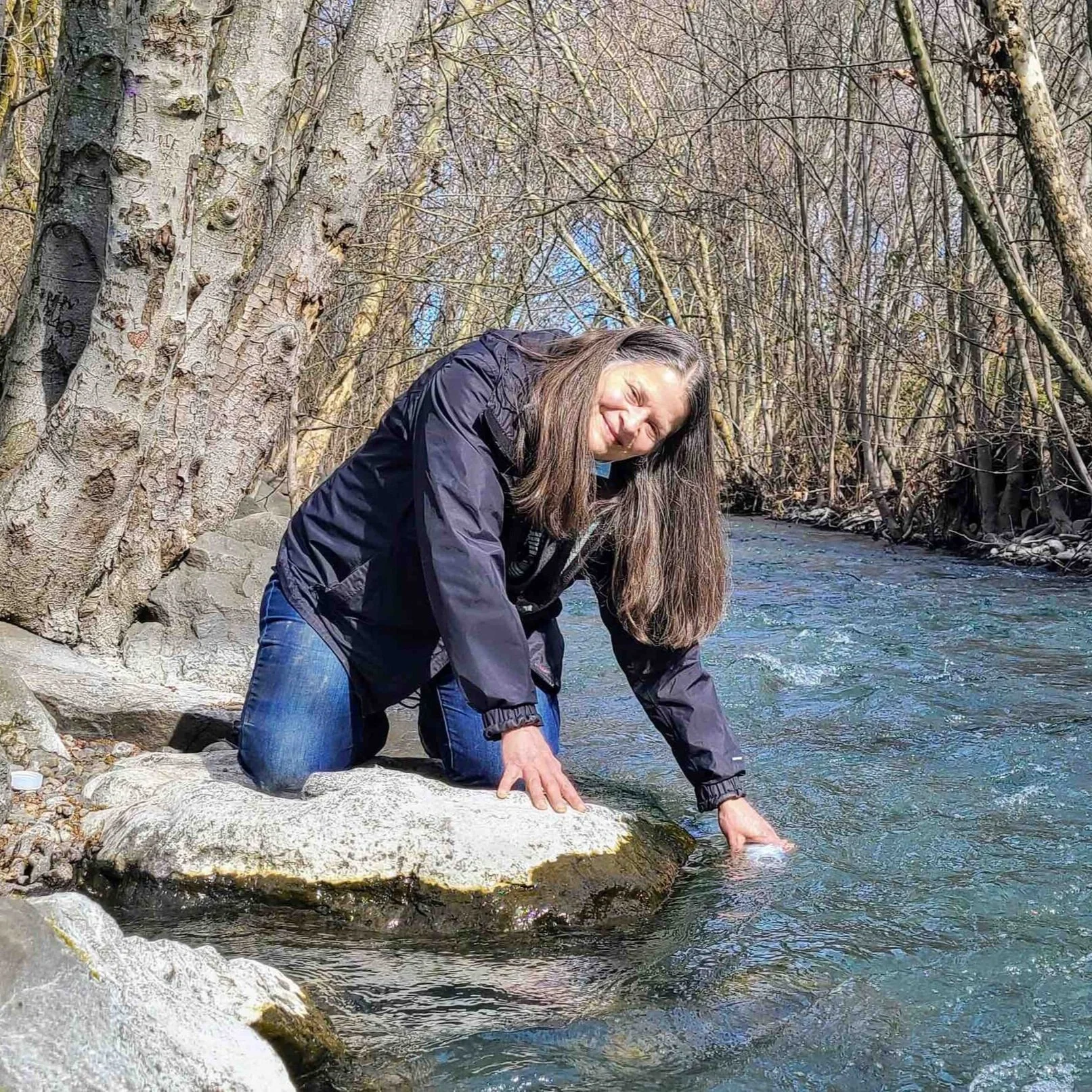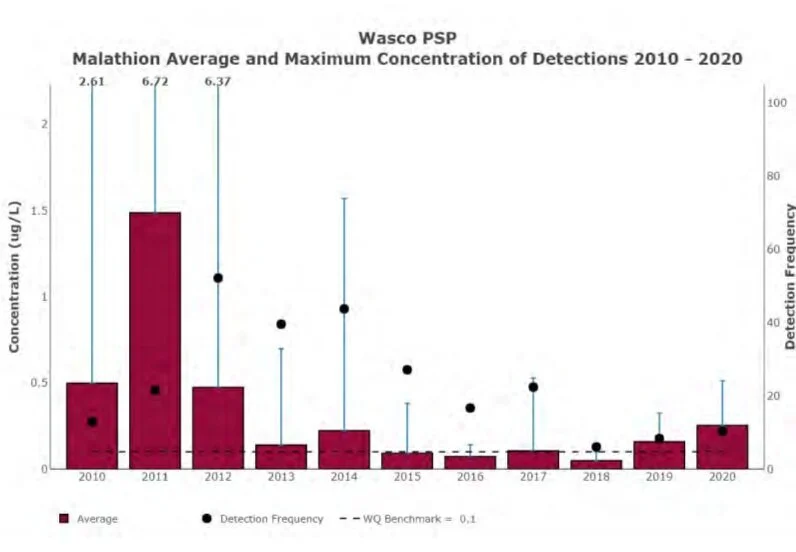PSP Reports Pesticides in Wasco Watersheds Are At Lowest Ever
March 17th, 2021 Conservation Planner Karen Lamson collecting water samples from Mill Creek in The Dalles.
March 17th, 2021 Conservation Planner Karen Lamson on route to collect water samples from Mill Creek in The Dalles.
The Wasco County Soil Water Conservation District (SWCD) began its first round of water testing last week as a part of it’s volunteer Pesticide Stewardship Partnership with the Oregon Department of Agriculture (ODA) and Oregon Department of Environmental Quality (DEQ). The PSP volunteer project monitors insecticides, pesticides, herbicides, and fungicides in Wasco County watersheds and has reported a downward trend in pesticide detections over the last ten years.
Monitoring locations include Mill Creek, Threemile Creek, and Fifteen Mile Creek. 15 samples will be taken at different points in the season. Results are analyzed in the Portland DEQ lab and released at the end of every field season which typically runs March-July.
March 17th, 2021 Karen Lamson places a Mill Creek water sample in a cooler.
The Downward Trend of Pesticide Detections in Wasco County
According to the Wasco SWCD and DEQ there is a downward trend in pesticide detections in Wasco County. According to their 2019-2020 report there are approximately 130 insecticides, herbicides and fungicides and their breakdown products that were analyzed. The data continued to show a downward trend in detections, and 2019 saw the lowest number of pesticide detections since monitoring began in 2010, with less than 50 detections. Of which, only 3 detected pesticides exceeded the benchmark for impact to aquatic species.
“We are a big success story in Oregon for pesticide monitoring and efforts” said Abbie Forrest, Watershed Coordinator at Wasco SWCD.
Pictured: Graph showing the number of ALL TOTAL Pesticide detections from 2010 to 2019.
“The number of detections of all insecticides in Wasco County streams has been below 10 detections for the last three years, compared to a peak of over 40 detections in 2014.” said Kevin Masterson, Oregon Department of Environmental Quality, Agency Toxics Coordinator.
“In addition, detections of all individual pesticide chemicals (insecticides, herbicides, fungicides, etc.) or breakdown products in 2020 was down to 9 detections from a peak of 16 detections in 2015, which is the lowest number of chemicals we’ve seen in those streams since 2010.”
In addition, two herbicides that are of concern for water quality statewide – diuron and simazine – which were detected many times in 2010 and 2011, and have not been detected in the Wasco project area since 2018.
“Diuron is not used by agricultural producers in the Wasco, although it has been used for rights-of-way vegetation management and other non-ag uses,” said Masterson.
Malathion in Wasco County
“The pesticide of highest concern in the Wasco watersheds is malathion, which is used in rotation with other insecticides to control pests in cherry orchards.” said Masterson. “We’ve seen an uptick in malathion concentrations over the past two monitoring years (2019 and 2020), but are still only detecting it in about 10% of the samples, compared with around 50% of samples in 2012.”
Malathion is an insecticide commonly used to control mosquitos and a variety of other insects that attack fruits, vegetables, and other plants. It is also used in many flea and tick sprays and lice shampoos. Malathion kills insects by targeting their nervous systems. It is highly toxic to bees and other beneficial insects, some fish and aquatic life.
The EPA and state aquatic life water quality criterion for malathion is quite low (0.1 parts per billion). Exceedances of that standard in Wasco County have been recorded multiple times over the past ten years.
“In 2018 we saw the lowest average concentration of detections and number of detections of malathion since the project began, with no samples exceeding the water quality criterion,” said Masterson.
How do these trends compare to other conservation districts in the state and nationally?
Masterson said it’s challenging to make comparisons between PSP project areas around the state because land uses and crops vary so widely.
“For instance, cherries are much more prevalent in the Wasco area than any other PSP watershed, and malathion is a chemical used for cherry pests more than other crops that dominate other PSP watersheds. As a result, malathion is detected more than in those other watersheds.”
Still some comparisons can be found.
“Carbaryl can be used for multiple purposes in many tree fruit crops in Oregon, and the levels of carbaryl in streams - and the up and down pattern of those levels over time – is very similar in the Wasco, Hood River and Walla Walla (Milton-Freewater) watersheds where tree fruit are major crops,” said Masterson
“The overall number of pesticide ingredients (and breakdown products) found in the Wasco, Hood and Walla Walla watersheds are much lower than PSP watersheds in the Willamette Valley where we often see 25-30 individual pesticide chemicals each year,” said Masterson. “Those watersheds encompass more diverse agricultural crops which involve different pesticides, as well as more urban areas than the PSP watersheds on the east side of the Cascades.”
What has caused the downward trend in pesticide detections?
According to Masterson, the overall reduction in concentrations and frequency of detection of insecticides in the Wasco, compared with the 2011 baseline year, can be attributed to multiple factors according to feedback received from growers and groups they work with.
A few of these factors include:
Using less toxic chemistries or alternatives to chemical pest controls.
Relying more on ground spraying for orchard blocks closest to streams, while still using aerial spraying in other parts of orchards that are further from surface waters.
Increased use of weather stations to ensure pesticide applications occur only when wind speeds and other meteorological conditions are conducive for minimal pesticide drift
In addition, many non-agricultural uses (e.g., roadway and other rights-of-way vegetation control) of more persistent and toxic herbicides like diuron have been reduced and replaced with less environmentally impactful herbicides.
“The changes and improvements made by growers and other pesticide users is the result of a proactive and attentive approach to water quality and pest management taken by local growers, OSU Extension, the SWCD and watershed councils,” said Masterson.
“The recent increase in concentrations of two insecticides (malathion, carbaryl) may also be attributable, in part, to the reduced sharing of water quality data due to the pandemic,” said Masterson. “We haven’t provided as much of a feedback loop to growers about how things are looking in the water, which we’re working on improving now.”
The Volunteer PSP Project Has Been in Operation for Over 10 Years
March 17th, 2021 Conservation Planner Karen Lamson collecting water samples from Mill Creek in The Dalles.
An initial pilot of the program began in 2002-2005 with a focus on Mill Creek. Water quality improvements were seen during that time, but there wasn’t adequate funding to continue the monitoring. The Wasco SWCD approached DEQ about restarting the project in 2010, coinciding with the arrival of the Spotted Wing Drosophila pest in local cherry orchards and an increased use of old and new insecticides to control the crop damage from the pest. The Wasco PSP project has continued uninterrupted since 2010.
“We are non-regulatory, everything we do is volunteer and in partnership with other agencies, and landowners,” said Forrest. WASCO SWCD are not here to “check up on the neighbors” so to speak. Wasco SWCD works WITH landowners, growers, and agencies to work together to monitor the impact of pest management practices and protect against spray drift and runoff.
Masterson said that an explicit nod should also be given to the work of OSU Extension, growers and watershed councils (in addition to the SWCD) as they are the “key players in making things happen and responding to the data findings.”
Interested in Getting Involved in the Wasco SWCD or Pesticide Stewardship Project?
Check out WCWatersheds.org for more information.
Or Contact:
Abbie Forrest, Watershed Coordinator at Abigail.Forrest@or.nacdnet.net
Drake Gilbert, FAST Coordinator at Drake.Gilbert@usda.gov










